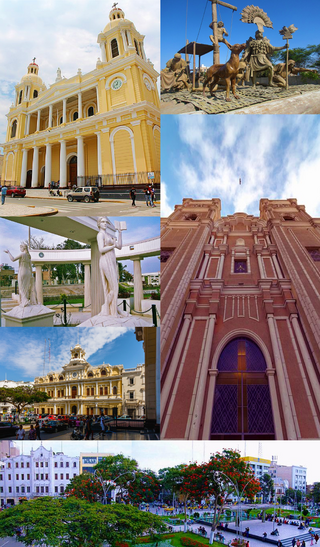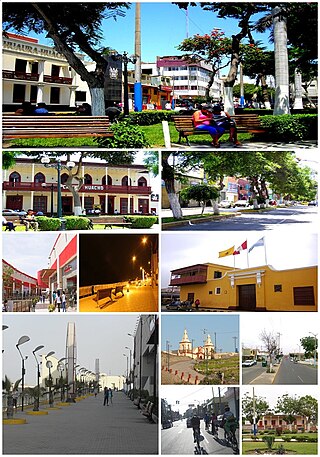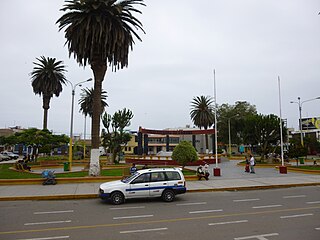
Moyobamba or Muyupampa is the capital city of the San Martín Region in northern Peru. Called "Santiago of eight valleys of Moyobamba" or "Maynas capital". There are 50,073 inhabitants, according to the 2017 census. Some 3,500 species of orchids are native to the area, which has led to the city's nickname of The City of Orchids. The city is the capital of both Moyobamba Province and Moyobamba District.

Chiclayo is the principal city and capital of the Lambayeque region and Chiclayo Province in northern Peru. It is located 13 kilometers from the Pacific coast, 208 kilometers from the city of Trujillo and 770 kilometers from the country's capital, Lima. It was founded under the name of "Santa María de los Valles de Chiclayo".

Huacho is a city in Peru, capital of the Huaura Province and capital of the Lima Region. Also is the most populated city of the Lima Region and Norte Chico. It is located 223 feet above sea level and 148 km north of the city of Lima. The city is located on the Pan-American Highway and it is close to the Lachay National Reserve, so it has extensive vegetation and wildlife.

Monsefú is a town in Northern Peru, capital of the Monsefú district in the Chiclayo Province that is part of the Lambayeque Region. It is renowned for its food and handicrafts, which are on display at the annual FEXTICUM festival, named in 1973 by Professor Limberg Chero Ballena and held in July during Fiestas Patrias. Monsefú is also the home of cumbia groups Grupo 5 and Hermanos Yaipen. Monsefú was elevated to the category of "city" on October 26, 1888.

San Vicente de Cañete, commonly known as San Vicente or Cañete, is a city and capital of the Cañete Province, in southern Lima Region. With a population of 85,533.

Lambayeque is a city on the coast of northern Peru and capital of the homonymous district and province in the department of Lambayeque. It is located 4.7 km from the city of Chiclayo and 13 km from the Pacific Ocean. It is an important cultural and educational center of the department as it houses some of the most important museums in the country, such as the Royal Tombs Museum and the Brüning Museum. It was founded in 1553 under the name of San Pedro de Lambayeque by order of the Viceroy Conde de Nieva.

Camaná is the district capital of the homonymous province, located in the Department of Arequipa, Peru. In 2015, it had an estimate of 39,026 inhabitants.

Jaén, founded as San Leandro de Jaén and then known as Jerez de la Frontera and finally as Jaén de Bracamoros since April 1549, is a city which is the capital of the Jaén Province in the Cajamarca Region in Peru, located in the high jungle of northern Peru. It is the seat of the Catholic Apostolic Vicariate of St. Francis Xavier, also known as Apostolic Vicariate of Jaén en Peru.

Ilo is a port city in southern Peru, with 66,118 inhabitants. It is the second largest city in the Moquegua Region and capital of the Ilo Province.

Chachapoyas is a city in northern Peru at an elevation of 2,335 meters (7,661 ft). The city has a population of 32,026 people (2017). Situated in the mountains far from the Peruvian coast, Chachapoyas remains fairly isolated from other regions of Peru. It is served by buses to Chiclayo and Cajamarca, and flights to domestic locations from Chachapoyas Airport.

Tarapoto is a commercial hub town in the San Martín Province of the Department of San Martín of northern Peru. It is an hour by plane from Lima, in the high jungle plateau to the east of what is known as the selva baja. Although Moyobamba is the capital of the region, Tarapoto is the region's largest city and is linked to the Upper Amazon and the historic city of Yurimaguas by a relatively well-maintained transandean highway, paved in 2008–9.

Yurimaguas is a port town in the Loreto Region of the northeastern Peruvian Amazon. Historically associated with the Mainas missions, the culturally diverse town is affectionately known as the "Pearl of the Huallaga". Yurimaguas is located at the confluence of the majestic Huallaga and Paranapura Rivers in the steamy rainforests of northeastern Peru. It is the capital of both Alto Amazonas Province and Yurimaguas District, and had a population estimated at 62,903 inhabitants (2017).

Andahuaylas, founded in 1533 as San Pedro de Andahuaylas «La Grande de la Corona», is a Peruvian city. It is the capital of the Andahuaylas Province in the Apurímac Region. It is known as the pradera de los celajes. Its approximate population of 42,268 inhabitants makes it the largest city in the region.
Florida is one of the twelve districts of the Bongará Province in the Amazonas Region of Peru. Its seat is Pomacochas, also named Florida. It is located approximately 90 km from Bagua Grande, at the route of the Peruvian forest for the marginal highway of the forest, today called Fernando Belaunde Terry.

Chepén is a city of La Libertad Region and capital of the Chepén Province, in Peru. The city is a rice production center with the valleys of Chepén and Jequetepeque, and has an active trading with neighboring Guadalupe, Pacasmayo and San Pedro de Lloc and other towns. It has factories in industrial dyes, food and primary production.
Casa Grande is a town in Northern Peru, capital of the district of Casa Grande of Ascope Province in the region La Libertad. This town is located beside the Pan-American Highway some 48 km north of Trujillo city in the agricultural Chicama Valley.

Ilave, also known as Illawi, is the capital city of the Ilave District in El Collao Province, in the Puno Region of Peru. According to the projection of the 2012 census, it has 57,366 inhabitants. It is located on the Ilave River and west from Lake Titicaca.
Club Social y Deportivo Sporting Victoria is a Peruvian football club, playing in the city of Bagua Grande, Amazonas, Peru.


















